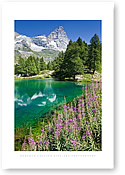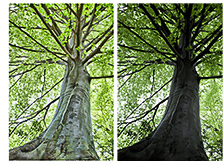| |
FINE ART WORKFLOW part 1
The whole creative process is designed to produce prints that offer museum quality level ; this process is composed of both technical and artistic aspects:
- HIGH-RESOLUTION DIGITAL CAMERA, PROFESSIONAL LENS AND OTHER GEARS

The technical quality of a photograph is determined by its sharpness, smoothness, tonal range, depth of colors. These aspects can be offered only by high-end professional photographic gears. These cameras are equipped with large digital sensors and specific design features; obviously their cost is proportional to the quality offered. The lenses used on these devices must be of equal quality: I use only fine prime lens and professional zoom. Clearly the shot is stored in RAW format that can then be optimally developed. Other important accessory: a solid tripod, a complete seat of filters (polarizer, graduate, nd), timer shooting.
- REFINED AND TASTEFUL COMPOSITION
 Art means freedom of expression. The avant-garde artists often use extreme language in order to distinguish and highlight their innovative capacity. Sometimes these languages are not easily comprehensible to the widest audience. For this reason contemporary art is considered by many irksome if not unpleasant. Art means freedom of expression. The avant-garde artists often use extreme language in order to distinguish and highlight their innovative capacity. Sometimes these languages are not easily comprehensible to the widest audience. For this reason contemporary art is considered by many irksome if not unpleasant.
Instead my fine art photographs want to reach a wide audience: I apply to my images rules of composition widely shared in western art. Obviously these rules are only a basic guide, the photographer has to find a personal style that makes his works unique and recognizable.
|
|
- EDITING SOFTWARE AND CALIBRATED HARDWARE
 In digital photography is very important to maintain control of the characteristics of the image throughout the creative process: from camera to print. To this end the equipment used for the image processing (camera, pc, monitor, printer) must be fully calibrated: for instance you should be using a profiled monitor and printer to really see what you're going to get. In itself, the monitor must be a specific model for the digital processing (I use Eizo monitor). Furthermore, the editing software must be able to manage optimally the image that, remember, must be edit as a tif file, 16 bit, ProPhoto RGB color space. So, the RAW files are developed using Adobe Camera Raw, than edit in Photoshop CS4 (with many useful plug-in to optimize noise removal, sharpness, contrast, HDR effect). In digital photography is very important to maintain control of the characteristics of the image throughout the creative process: from camera to print. To this end the equipment used for the image processing (camera, pc, monitor, printer) must be fully calibrated: for instance you should be using a profiled monitor and printer to really see what you're going to get. In itself, the monitor must be a specific model for the digital processing (I use Eizo monitor). Furthermore, the editing software must be able to manage optimally the image that, remember, must be edit as a tif file, 16 bit, ProPhoto RGB color space. So, the RAW files are developed using Adobe Camera Raw, than edit in Photoshop CS4 (with many useful plug-in to optimize noise removal, sharpness, contrast, HDR effect).
- A DIGITAL IMAGE PROCESSING THAT ENHANCES THE STRENGTH OF THE COMPOSITION
 Photography means sharing our experiences. We perceive the world around us using the five senses; unfortunately the camera has a single sense and all it can produce is a simple two dimensional image. It's easy to understand how difficult it is to reproduce, using this media, the complex mix of feelings we felt when taking the picture. To this purpose the photographers use a lot of tricks: prospective, narrow depth of field, filters, telephoto or wide angle lens, hue variation, chromatic associations, black and white and many others. In digital era we have new tools that could help us in this purpose: the modern editing software are really powerful because they allow us to apply both local and global correction. At the end we get a "new version" of the original image: it's not more similar to reality but it's closer to the feeling that we wanted to share. Photography means sharing our experiences. We perceive the world around us using the five senses; unfortunately the camera has a single sense and all it can produce is a simple two dimensional image. It's easy to understand how difficult it is to reproduce, using this media, the complex mix of feelings we felt when taking the picture. To this purpose the photographers use a lot of tricks: prospective, narrow depth of field, filters, telephoto or wide angle lens, hue variation, chromatic associations, black and white and many others. In digital era we have new tools that could help us in this purpose: the modern editing software are really powerful because they allow us to apply both local and global correction. At the end we get a "new version" of the original image: it's not more similar to reality but it's closer to the feeling that we wanted to share.
|